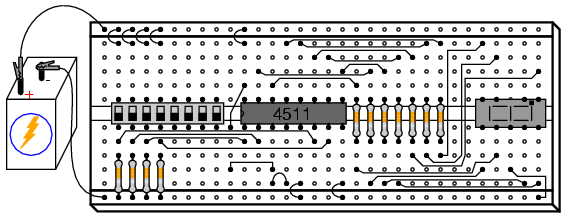7-segment display
PARTS AND MATERIALS
-
4511 BCD-to-7seg latch/decoder/driver
(Radio Shack catalog # 900-4437)
-
Common-cathode 7-segment LED display
(Radio Shack catalog # 276-075)
-
Eight-position DIP switch (Radio Shack
catalog # 275-1301)
-
Four 10 kΩ resistors
-
Seven 470 Ω resistors
-
One 6 volt battery
Caution! The 4511 IC is CMOS, and
therefore sensitive to static electricity!
CROSS-REFERENCES
Lessons In Electric Circuits, Volume
4, chapter 9: "Combinational Logic Functions"
LEARNING OBJECTIVES
-
How to use the 4511 7-segment
decoder/display driver IC
-
Gain familiarity with the BCD code
-
How to use 7-segment LED assemblies to
create decimal digit displays
-
How to identify and use both "active-low"
and "active-high" logic inputs
SCHEMATIC DIAGRAM

ILLUSTRATION

INSTRUCTIONS
This experiment is more of an introduction
to the 4511 decoder/display driver IC than it is a lesson in
how to "build up" a digital function from lower-level
components. Since 7-segment displays are very common
components of digital devices, it is good to be familiar
with the "driving" circuits behind them, and the 4511 is a
good example of a typical driver IC.
Its operating principle is to input a
four-bit BCD (Binary-Coded Decimal) value, and energize the
proper output lines to form the corresponding decimal digit
on the 7-segment LED display. The BCD inputs are designated
A, B, C, and D in order from least-significant to
most-significant. Outputs are labeled a, b, c, d, e, f, and
g, each letter corresponding to a standardized segment
designation for 7-segment displays. Of course, since each
LED segment requires its own dropping resistor, we must use
seven 470 Ω resistors placed in series between the 4511's
output terminals and the corresponding terminals of the
display unit.
Most 7-segment displays also provide for a
decimal point (sometimes two!), a separate LED and terminal
designated for its operation. All LEDs inside the display
unit are made common to each other on one side, either
cathode or anode. The 4511 display driver IC requires a
common-cathode 7-segment display unit, and so that is what
is used here.
After building the circuit and applying
power, operate the four switches in a binary counting
sequence (0000 to 1111), noting the 7-segment display. A
0000 input should result in a decimal "0" display, a 0001
input should result in a decimal "1" display, and so on
through 1001 (decimal "9"). What happens for the binary
numbers 1010 (10) through 1111 (15)? Read the datasheet on
the 4511 IC and see what the manufacturer specifies for
operation above an input value of 9. In the BCD code, there
is no real meaning for 1010, 1011, 1100, 1101, 1110, or
1111. These are binary values beyond the range of a single
decimal digit, and so have no function in a BCD system. The
4511 IC is built to recognize this, and output (or not
output!) accordingly.
Three inputs on the 4511 chip have been
permanently connected to either Vdd or ground:
the "Lamp Test," "Blanking Input," and "Latch Enable." To
learn what these inputs do, remove the short jumpers
connecting them to either power supply rail (one at a
time!), and replace the short jumper with a longer one that
can reach the other power supply rail. For example,
remove the short jumper connecting the "Latch Enable" input
(pin #5) to ground, and replace it with a long jumper wire
that can reach all the way to the Vdd power
supply rail. Experiment with making this input "high" and
"low," observing the results on the 7-segment display as you
alter the BCD code with the four input switches. After
you've learned what the input's function is, connect it to
the power supply rail enabling normal operation, and proceed
to experiment with the next input (either "Lamp Test" or
"Blanking Input").
Once again, the manufacturer's datasheet
will be informative as to the purpose of each of these three
inputs. Note that the "Lamp Test" (LT) and "Blanking Input"
(BI) input labels are written with boolean complementation
bars over the abbreviations. Bar symbols designate these
inputs as active-low, meaning that you must make each
one "low" in order to invoke its particular function. Making
an active-low input "high" places that particular input into
a "passive" state where its function will not be invoked.
Conversely, the "Latch Enable" (LE) input has no
complementation bar written over its abbreviation, and
correspondingly it is shown connected to ground ("low") in
the schematic so as to not invoke that function. The "Latch
Enable" input is an active-high input, which means it
must be made "high" (connected to Vdd) in order
to invoke its function.
|